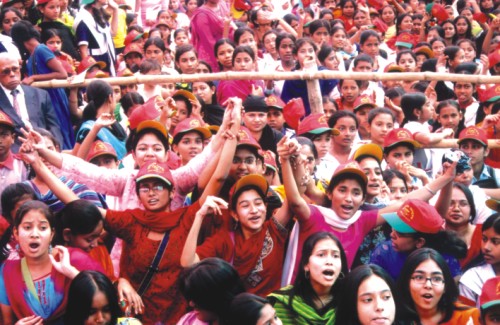|
Achievement
Bringing the Liberation War Closer to Kids
Srabonti Narmeen Ali
It started off as the brainchild of eight friends -- affectionately known as 'shaat bhai Champa ak bon Parul,' (seven brothers and one sister) -- who wanted to build a national museum commemorating the 1971 liberation war. Thus twelve years ago, on March 22, 1996, team of friends, consisting of Asaduzzaman Noor, Aly Zaker, Sara Zaker, Rabiul Hossain, Dr. Sarwar Ali, Akku Chowdhury, Mofidul Hoque and Tariq Ali, launched the Muktijuddha Jadughor (Liberation War Museum).
"All countries that have been through a huge sacrifice have a state museum," says Dr. Sarwar Ali. "But the reality is that the political forces' interpretation of history is often very different from the common person's story.
"We are not a conventional museum. In fact when we started out we wanted to bring the history of the people beyond the four walls of the museum, especially for the youth who generally have a very distorted version of the facts of what happened in '71."
In order to avoid bringing in additional biases to further distort the history, the trustees of the museum have made an effort to remain impartial. "Back when we first started there was a very strong political divide," says Mofidul Hoque, "so in order to stay neutral we decided that we would depict the history only until December 16, 1971."

The trustees of the museum wanted to create an environment where
people could come and see the evidence and the facts, and then
make up their own minds about the course of history.
What the trustees of the museum are definitely not neutral about, however, is the cause itself. For twelve years they have worked at disseminating information to the youth, trying to find a way to tell the real stories of real people. Their total count of memorabilia from the war are over 14,000, making the museum the largest reposition of memorabilia from the Bangladesh liberation war in the world.
Aside from having many different events and functions, the Muktijuddha Jadughor is unique from others of its kind in one special way. In order for them to mobilise the youth and educate them about the history the museum started a programme for school students in 1997. The school programme, targeting many schools around the nation, serves to make the youth understand the importance of what happened in 1971. Museum trustees travel to different schools in different villages outside of Dhaka, while those students who study in the capital come to the Jadughar for the programme.

The museum organises various events that involve children and tries to incorporate the education of not only the war, but also human rights and learning to tolerate and respect people of other cultures.
There are four elements of the school programme. The first is the travelling or mobile museum, incorporated in 2000, in which artifacts of the museum are taken to different schools in almost every thana in Bangladesh, so that school children who may not be able to travel all the way to Dhaka to come to the museum will have the museum brought to them. The second element is that of the exhibition of the Universal Declaration of Human Rights, in which each of the thirty basic rights defined in the 1940 Declaration are depicted and defined in the form of a cartoon. The third element comprises of a workshop on tolerance and living with each other. In this museum trustees usually talk about people of all different nations, not only Adibashis, Hindus, Muslims, Buddhists and Christians, but also incorporating cultures from China and Spain. The whole concept is that "the world is a global village" and therefore we must learn to not only accept that there are people who are different from us, but also learn to appreciate them -- a mentality, that over three decades ago, could have been implemented during the war in order to avoid so much bloodshed and unhappiness. Possibly the most important part of the school programme is the fourth element, in which they ask the students from the most remote areas and schools to interview their parents and grandparents about their experiences during the war. To date, the museum has collected over 7,700 stories written by these schoolchildren.
"What we are doing here is basically getting an account of the peoples' war rather than the soldier's war, which is usually what we hear," says Hoque, "And it is through the mouths of our children, who pass on these stories from their older generation in their own language. We provide them with the opportunity and that platform to be able to do so."

As part of their school programme the museum encourages students all over Bangladesh to interview their families' about the war and write about these experiences
What is most important to the trustees is that the memory of the war does not fade away. It is the collective memory of a nation that gives it the pride to fight against injustice and work towards a better future. That old broken down house in Shagunbagicha which these eight individuals built up with their own resources and their own strength soon became a haven for those people who take pride in our nation's past. It is these people who adopted an ownership for this museum, offering support, participating in events and making a general effort as a united community.
Copyright
(R) thedailystar.net 2007
|
